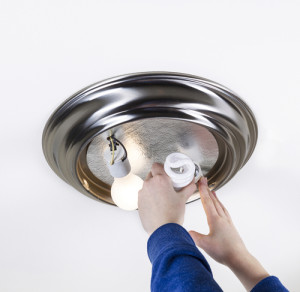 It’s not just about wattage anymore. Light fixtures and light bulbs come in myriad types, sizes and colors. Do you want LED? Should you use “soft” bulbs? And what is the difference between watts and lumens? With the phase-out of the traditional incandescent bulb, the lighting choices you grew up with are not the same as what will be available in the future. The best thing you can do is learn what the different options are and decide which one might be best for you, so you’ll know what to ask for when calling in and scheduling residential electrical installs.
It’s not just about wattage anymore. Light fixtures and light bulbs come in myriad types, sizes and colors. Do you want LED? Should you use “soft” bulbs? And what is the difference between watts and lumens? With the phase-out of the traditional incandescent bulb, the lighting choices you grew up with are not the same as what will be available in the future. The best thing you can do is learn what the different options are and decide which one might be best for you, so you’ll know what to ask for when calling in and scheduling residential electrical installs.
When making choices for your new home, consider the light’s expected usage, the use of the room and the availability of replacement bulbs. For your commercial lighting, industrial lighting, outdoor lighting needs go to CDM2Lightworks.com.
How Light Works
Artificial light affects how color appears on your walls and ceilings. That is why paint colors that seemed so perfect at the paint store can look all wrong on your walls. Some popular bulbs for home use will change how color appears, and how a room “feels” when the lights are on.
- Incandescent bulbs. The bulbs we grew up with typically have a warm cast and brighten up colors in the warmer spectrums (reds, oranges, yellows) and dampen colors in the cool spectrum. However, as of this year (2014) most incandescent bulbs will be phased out for general use. Although there are exceptions for specialty bulbs, including some sizes of the very popular designer Edison bulb, when your bulb goes, you’ll need to replace it with some form of fluorescent or halogen bulb. Or, you’ll need a new light fixture altogether.
- Standard fluorescent bulbs. The long tubes used in schools, retail stores and offices emit cooler colors that enhance greens, blues and purples while subduing reds, oranges and yellows. These bulbs often “hum” in the background. Better for work areas (kitchen, garage), standard fluorescents offer an economical lighting source.
- CFLs. Compact fluorescents are the obvious choice to replace incandescent bulbs. With bayonets that fit most light fixtures, CFLs are available in a variety of sizes, shapes and wattages. They also have a Kelvin rating which determines the color spectrum of the bulb. The lower the Kelvin number, the warmer the colors. A “full spectrum bulb” is designed to mimic daylight.
- LEDs. Light-emitting diodes emit a warmer light. Often the “bulb” has a reflective cone that augments the light. LED light enhances most paint colors and gives natural lighting that works well for bathrooms and dressing areas.
- Halogen. Because of their whiter, brighter light and longevity theater stages use halogen lights for high performance applications. In the home, halogens reduce eyestrain as reading lights, offer safety and security to your outdoors and highlight your artwork. They burn hotter than other lights, though, so don’t belong in areas where the bulb can’t be shielded. Some older halogen fixtures—especially torchiere lamps—posed a fire hazard from the hot-burning bulb, so check to make sure your halogen fixtures have protective shields. Learn about the differences between led vs halogen downlights on Simple Lighting’s blog post.
Replacing Fixtures
When replacing light fixtures, consult a lighting designer to solve lighting challenges and create the most economical arrangement of your lighting profile. You may also need a professional electrician for your Home Lighting Installation job. A licensed and experienced electrician can help you determine the best lighting upgrades for the sale of your home.
Compliments of Virtual Results






 Catch Our Feed
Catch Our Feed Subscribe via Email
Subscribe via Email Follow Our Tweets
Follow Our Tweets Friend Us On Facebook
Friend Us On Facebook Watch Us On Youtube
Watch Us On Youtube